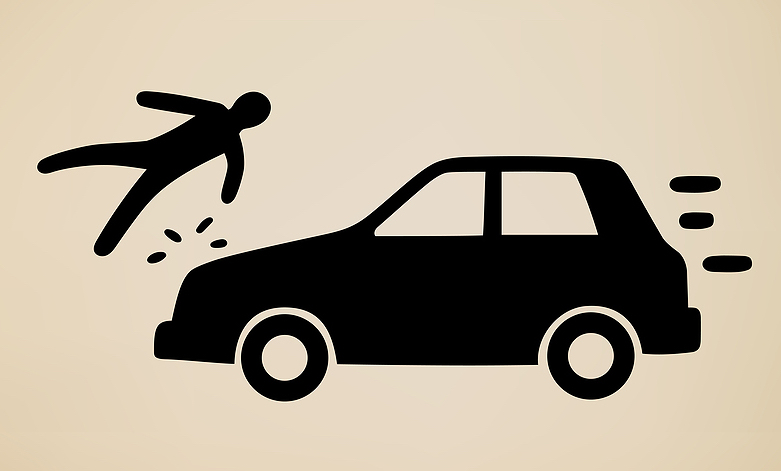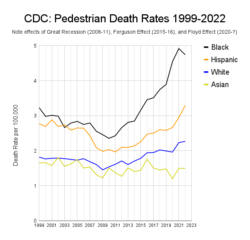
January 03, 2024

Source: Bigstock
Why are American pedestrians getting run over so much more often than a decade and a half ago?
You’re not just imagining it: It really has gotten more dangerous to cross the street.
Since 2009, the worst year of the Great Recession, pedestrian death rates per 100,000 people increased 63 percent by 2022, while motorist (driver and passengers) death rates per capita have gone up only 10 percent.
One reason is likely that vehicles continue to get safer for their occupants, but pedestrians are not getting more nimble. In fact, Americans on average are likely slightly older, fatter, and less quick on their feet today than in 2009.
Vehicles aren’t getting smaller either, so pedestrians who get hit by cars (or, increasingly, trucks) are less likely to survive the encounter. And trendy electric vehicles, with their massive batteries, are just making the odds worse. Yet, American automobiles were already pretty huge in 2009. Remember the Hummer and the Ford Excursion?
One curious development uncovered by New York Times staffers last month is that almost all the increase in pedestrian death rates has been happening at night:
Why Are So Many American Pedestrians Dying at Night?
By Emily Badger, Ben Blatt, and Josh Katz
Dec. 11, 2023
I could well imagine that the introduction of LED headlights and streetlights has made driving at night worse. In theory, LEDs should be better than their predecessors, but in practice, LED headlights seem to glare while LED streetlights fail to illuminate.
Perhaps as people have gotten fatter, we’ve taken to wearing darker clothes to cover up our bulk? In general, contemporary tastes run toward dull colors, both in clothes and car paint.
The Times theorizes that all the glowing screens in cars these days make it harder to see strollers at night.
Hence, when walking my dog at night, I’ve lately started wearing a yellow road worker’s safety vest. It’s not stylish, but neither is getting flattened by some jerk in a BMW.
But whatever is going on on American roads that is getting pedestrians killed at night is not much happening in the two America Jrs., Canada and Australia:
What’s even more perplexing: Nothing resembling this pattern has occurred in other comparably wealthy countries. In places like Canada and Australia, a much lower share of pedestrian fatalities occurs at night, and those fatalities—rarer in number—have generally been declining, not rising.
The Times speculates that while European drivers need one hand for the steering wheel and one hand for the stick shift, Americans have a free hand to fool around with their glowing smartphones at night because American cars are almost all automatic transmissions.
That’s a clever idea. But Canadians and Australians aren’t Italians when it comes to devotion to manual transmissions. Supposedly, 97 percent of cars sold in Australia are automatics.
Now, it could be that there are subtle technical differences between American and Canadian automobiles or street lighting or whatever that are preventing this rise in nocturnal pedestrian deaths north of the border. I encourage further research and speculation on this life-or-death topic by those who know more than I do.
But what about behavior? Indeed, America has seen some strange behavioral changes in recent years, ones not witnessed in other countries with different racial demographics, such as our big increases in both motor vehicle accidents and homicides, especially among blacks, during both the Ferguson Effect (2015–16) and the Floyd Effect (2020–?). For example, according to Gun Violence Archive, there were 52 percent more gun homicides in 2023 than in 2014, the year Black Lives Matter came to be celebrated by the media during the August 2014 Ferguson riots. Even worse, mass shootings (four or more dead and/or wounded) were up 142 percent since Ferguson.
So, I graphed pedestrian deaths by race as tabulated in the CDC’s WONDER database of the causes of all deaths in the U.S.:

The most striking aspect is that the black pedestrian death rate has almost doubled since its low during the Great Recession. Contrary to the conventional wisdom, economic hard times tend to reduce deaths by traffic accident and homicide. This makes sense if you think of them as Deaths of Exuberance, more common when people have ample cash in their wallets.
By 2014, the black pedestrian death rate was back up to the level seen during the housing bubble of 2007, but growth was slowing. Then came the Ferguson Effect, as The Establishment warned cops not to police so proactively, and the black death rate shot upward as motorists sped more and packed more pistols. Indeed, the Ferguson Effect started in Ferguson, Missouri, when officer Darren Wilson shouted at jaywalker Michael Brown to get out of the street and back on the sidewalk.
Growth slowed somewhat in the late 2010s, but then came the Floyd Effect of the 2020s.
Among Hispanics, pedestrian deaths fell sharply with the bursting of the Housing Bubble. (It’s likely that many of the most marginal Latinos returned to Mexico when construction jobs evaporated.) As with homicides, Hispanics didn’t get the message as rapidly as blacks did about the racial reckoning, so their death rate peaked in 2022 rather than in 2021.
Whites have been slowly degenerating for a decade and a half, but didn’t rapidly respond to the racial reckoning.
Asians have kept their pedestrian death rate more or less flat for a decade and a half.
So, what we see is that the pedestrian death rate went up more among those for whom it was already worse. This is another example of the Matthew Effect often seen in the social sciences:
For unto every one that hath shall be given, and he shall have abundance: but from him that hath not shall be taken away even that which he hath.
The Asian example raises the question of how much the rise in pedestrian deaths is due to worse driving by motorists versus worse walking by pedestrians.
In the conventional wisdom, pedestrians are seen as the Good Guys, so the fact that they are getting hit more can’t possibly be their fault.
On the other hand, in my own neighborhood I’ve seen both more speeding and more jaywalking, especially of the puzzling variety near stoplights where pedestrians refuse to walk 100 feet down to the corner and instead plunge into traffic on a busy street.
This is a difficult question to answer from statistics because most people tend to walk amongst drivers of their own race. So the fact that, for instance, more black pedestrians have been getting hit in black neighborhoods by (presumably) black motorists doesn’t answer the question of who is increasingly at fault: drivers or walkers?
But only a few Asians spend their days in predominantly Asian communities. So, the fact that Asian pedestrians have managed to avoid getting killed more often by motorists suggests that the increased death tolls among black, Hispanic, and white pedestrians is partly the fault of increasingly reckless walkers.
This doesn’t mean that we shouldn’t be making long-term improvements in street and vehicle design, such as more crosswalks with blinking LEDs embedded in the pavement, to cut down on pedestrian deaths.
But infrastructure improvements take years or decades to have effect. What would save lives in the short term is going back to the more active policing of bad drivers and bad walkers that we had before we gave Black Lives Matter veto power over law enforcement.
That would require the media, however, to admit that they fouled up massively over the past decade. And they’d rather continue to have people die than confess their foolish guilt.